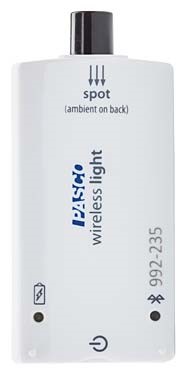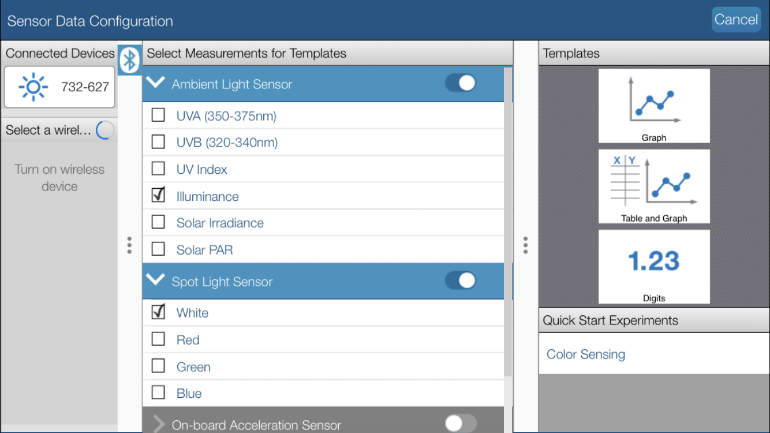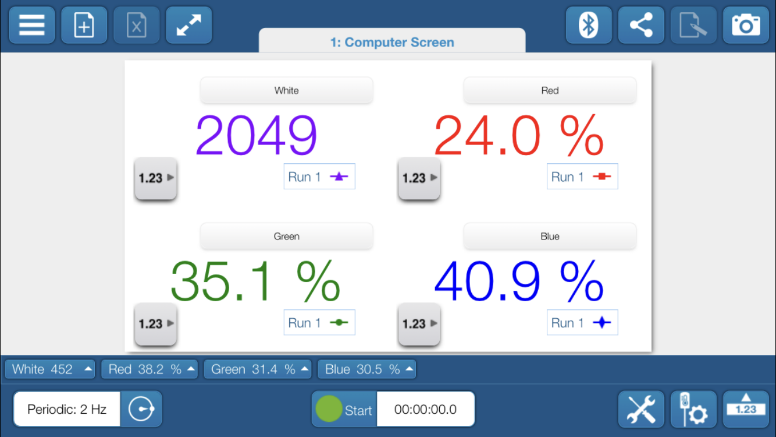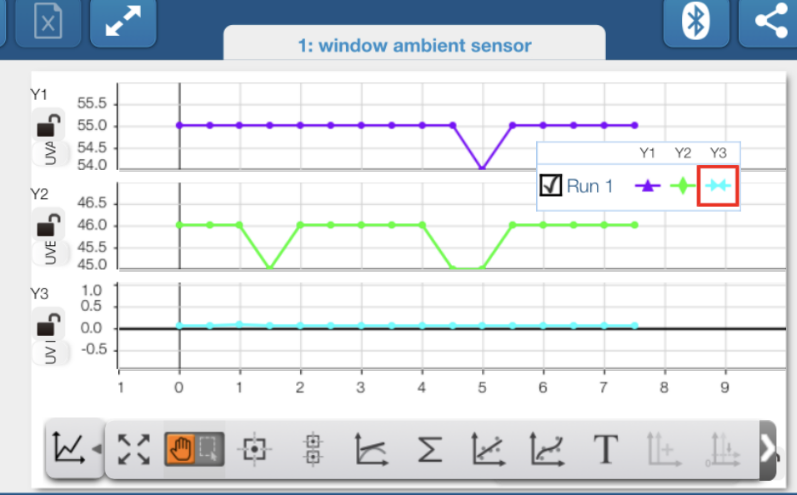Pasco's Wireless Light Sensor Revisited using SPARKvue…
By Edwin P. Christmann
Posted on 2019-02-22
Introduction:
The PASCO Wireless light sensor is a wireless device that measures ambient and directional light. Moreover, it has the capacity to stream data to devices via a Bluetooth connection, e.g., laptops, iPhones, or Android phones. There is a picture of the sensor that can be seen in Image 1. The light sensor has an ambient sensor on the back of the device to measure light’s illuminance, UVA, UVB, and the UV Index. Subsequently, light levels can be measured with a spot aperture that can detect color. For a more in-depth description and to order the product, feel free to visit the PASCO website at: https://www.pasco.com/prodCatalog/PS/PS-3213_wireless-light-sensor/index.cfm.

Image 1: Displays a picture of the sensor. The small sensor is approximately the size of the palm of an adult’s hand.
In order to begin data collection, student will need to connect their sensor to a device (e.g., cellphone) via a Bluetooth connection. To make this connection, they will need to use the PASCO data collection software. There are two choices of software to make this connection, i.e. SPARKvue or PASCO Capstone. We selected SPARKvue for our test of this product, which was very easy to download from the Apple “App Store.” Once that’s done and users are ready to connect their device to the light sensor, they must click on the Bluetooth icon within the PASCO data collection software. Next, they will select the device from the “Wireless Devices” list, matching the device ID number that’s found on the sensor. The Bluetooth light will blink green when their device is connected to the sensor. Once you get the greenlight, you are ready to start collecting data!
https://www.bing.com/videos/search?q=pasco+wireless+sensor&&view=detail&mid=561461DF848D60D55B53561461DF848D60D55B53&&FORM=VRDGAR
Video 2: PASCO Wireless Sensors: Getting Started with SPARKvue
To begin data collection, the first step is to start a new experiment. When starting a new experiment, users can choose the dependent variables (or in other words – what they are measuring). As an example, if using the ambient light sensor, measurements of UVA, UVB, UV, illuminance, solar irradiance, or solar PAR can be measured and reported. Moreover, if using the spot light sensor, it’s possible to measure white, red, green, and blue light-levels. Users have the option to select multiple measurements at a time if they wish (see Image 2). In addition, students are able to select how they would like their data displayed e.g., a graph, a table and a graph, or in digital form (see Image 3). To collect the light data, students need to hold their sensor towards the source of light being testing. Next, to initiate data collection, they need to push the start button (i.e., the green button located at the bottom portion of the screen). For users finish collecting data, all that’s necessary is to press the red stop button to stop data collection. Screenshots of the data in digital and graph format also appear below in Images 4.

Image 2: A screenshot of the options users see on the screen when setting up their new experiment.

Image 3: A screenshot of how data appears if users choose for their data to be displayed in digit format. The data shows the amount of white, red, green, and blue light emitted from a computer screen.

Image 4: A screenshot of what data looks like if users opt to have their data displayed in graph form. The data shows the amount of UVA, UVB, and UV found in the natural light coming through a window.
Classroom Applications:
The PASCO Wireless light sensor has a multitude of possible uses in a variety of subjects for students of various ages. There are a variety of ideas for classroom uses of the sensor provided for free on the PASCO website under the “Training and Resources” tab. After clicking this tab, users go to https://www.pasco.com/resources/videos/index.cfm for additional information. We found that PASCO’s Wireless Light Sensor is an excellent scientific instrument that is reasonably priced and easy to use! Moreover, PASCO’s SPARKvue is SPARKvue is a an excellent data collection tool with many applications for uses in STEM learning. If you are studying light and are looking for an easy and user-friendly way to collect data, consider using Pasco’s Wireless Light Sensor with SPARKvue.
Specifications:
Sensing Element
– Dual 5 channel radial photodiodes
Spectral Response
– Approximately 300 nm to 1100nm
– UVA (350-375 nm)
– UVB (320-340 nm)
Measurement Options
– Light intensity, RGB, UVA, UVB, and UV index
Resolution
– +/- 0.01 lx (spot aperture)
– +/- 2 lx (ambient aperture)
Sample Rate
– Ambient- Default: 1 Hz
– Ambient- Maximum: 2 Hz
– Spot- Default: 5 Hz
– Spot- Maximum: 20 Hz
Logging
– Yes
Battery
– Coin cell (expected battery life of over one year)
Connectivity
– Bluetooth Smart
Maximum Wireless Range
– 30 meters (unobstructed)
Cost:
$59 per device
Edwin P. Christmann is a professor and chairman of the secondary education department and graduate coordinator of the mathematics and science teaching program at Slippery Rock University in Slippery Rock, Pennsylvania. Emily Ferraro is a graduate student in the mathematics and science teaching program at Slippery Rock University in Slippery Rock, Pennsylvania.
Disclaimer: The views expressed in this blog post are those of the author(s) and do not necessarily reflect the official position of the National Science Teaching Association (NSTA).


